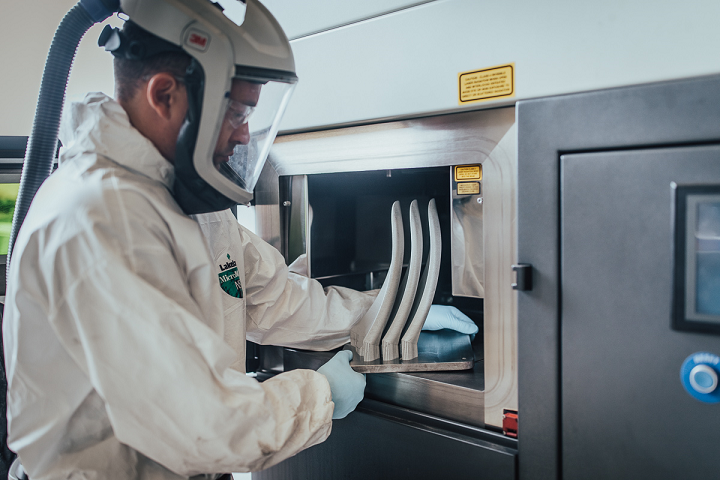Renishaw No Longer for Sale After Underwhelming Proposals
Four months after British engineering and metal 3D printer manufacturer Renishaw announced the sale of the company, the board decided to back out. Disappointed with all the takeover proposals, the almost 50-year-old company will not be selling any shares for the foreseeable future. Renishaw struggled to attract a buyer due to its high price and list of demands, according to information published by Bloomberg last May. In fact, founders Sir David McMurtry and John Deer had planned to sell their approximately 53% shareholding suggesting their age had a lot to do with the decision – both are currently in their 80s – but have recently indicated to the board their renewed commitment to the company, which they consider is currently in a “strong strategic and financial position.”
 Renishaw founders John Deer (left) and Sir David McMurtry (right). Image courtesy of Renishaw.
Renishaw founders John Deer (left) and Sir David McMurtry (right). Image courtesy of Renishaw.When the formal sale process was announced on March 2, 2021, the company determined that any potential buyer should recognize the innovative value of the business, respect its unique heritage and culture, commit to the local communities where it operates, and support long-term growth. However, just days later, Bloomberg also revealed that rival engineering companies Hexagon, Schneider Electric, and Siemens had decided against pursuing a Renishaw buyout. Since then, the Board stated it “carefully reviewed a number of proposals” with its advisers from UBS Investment Bank before unanimously concluding that “none would meet the Board’s objectives of delivering an outcome that satisfactorily met the interests of all stakeholders.”
McMurtry and Deer highlighted that their focus since the beginning of the process was to find the “right new owner for our business.” While this did not result in a buyout, the two said they are “satisfied that it ensured a thorough and rigorous process that enabled us to evaluate a wide range of potential buyers.” McMurtry and Deer will now continue in their roles as Renishaw Executive Chairman and Non-Executive Deputy Chairman, respectively.
During this time, Renishaw went through a bit of a roller coaster, with shares tumbling 17% just three days after the announcement, and plummeting in July, after the sale withdrawal decision. During the quarter ended in June 2020, Renishaw shareholders saw the share price fall 13%. However, expert advisers at Simply Wall St. say it’s important to also look at the “longer time horizon” when analyzing companies, and for Renishaw that translates to an impressive 148% share price increase. Currently valued at more than £1 billion ($1.4 billion), with a market cap of £3.6 billion ($5 billion), Renishaw shares trade in the London Stock Exchange under the market symbol RSW.
 3D printed ocean turbine parts being made by Renishaw. Image courtesy of Renishaw
3D printed ocean turbine parts being made by Renishaw. Image courtesy of RenishawOf course, the answer is not entirely linear when taking a closer look at the events that led to the sale decision. However, several indications in the past might have motivated the board to accept a formal sale process to encourage a competitive and confidential buyout under the UK Takeover Code. Primarily, during most of 2019, Renishaw took quite a toll when it revealed hefty net revenue losses after a weakened demand in its Asia market, which accounts for more than 40% of the group’s sales.
In 2020, its ledger didn’t improve either, with the engineering technology business announcing revenue was down again in its first quarter. At the time, Renishaw issued a profit warning just weeks after announcing the closing of its North Staffordshire factory, in Stone, with a potential loss of up to 120 jobs. However, the company managed to end the full year with a pre-tax profit of £48.6 million ($68 million) despite the impact of the COVID-19 pandemic on its revenue.
For the year 2021, however, Renishaw says it sees a “strong trading performance in the final quarter of the financial year ended 30 June 2021” and claims it “finished the year with a record order book.” As a result, management now expects revenue for the year ended 30 June 2021 to be in the range of £562 million ($780 million) to £567 million ($788 million) and adjusted profit before tax between £116 million ($161 million) and £121 million ($168 million), much closer to revenues and profit reported prior to 2020. The business’s renewed financial position is considered a stronghold moving forward for its Senior Independent Non-Executive Director, Sir David Grant, who also said he was pleased that the founders decided to continue as part of the business.
 Although Renishaw has now officially withdrawn from the buyout, UK financial experts often consider a formal sales process a signal that a company has run out of options. Since its introduction in 2011, interest in this process has been fairly underwhelming, explains Adam Cain, the Legal Director of UK firm Pinsent Masons. However, several public companies have chosen to launch formal sales processes, often referred to as FSPs, especially during the 2020 pandemic as they had to adjust to challenging trading conditions.
Although Renishaw has now officially withdrawn from the buyout, UK financial experts often consider a formal sales process a signal that a company has run out of options. Since its introduction in 2011, interest in this process has been fairly underwhelming, explains Adam Cain, the Legal Director of UK firm Pinsent Masons. However, several public companies have chosen to launch formal sales processes, often referred to as FSPs, especially during the 2020 pandemic as they had to adjust to challenging trading conditions.
Research by the law firm actually revealed that last year, 15 businesses announced FSPs, up from 13 in 2019 and 11 in 2018. Cain concluded that the increased pressure from a cash flow perspective might also lead more companies to take advantage of the flexibility of an FSP to find a strategic partner, particularly firms that have received a great deal of interest from prospective bidders and are seeking to conduct a competitive process.
 The Additive Assurance quality control system is installed on a Renishaw metal 3D printer. Image courtesy of Additive Assurance.
The Additive Assurance quality control system is installed on a Renishaw metal 3D printer. Image courtesy of Additive Assurance.Renishaw is known to develop metal powder bed fusion additive manufacturing systems that can build complex metal parts as a solution for a wide range of industry needs. The company has customers in some of the biggest industries on the planet, including healthcare and automotive. Recently, Renishaw partnered with the UK aerospace sector, receiving £26 million in funding to lead project LAMDA set to revolutionize local aerospace manufacturing through the development of a metal 3D printer capable of mass-producing smaller aircraft components to speed up and improve cost-efficiencies within aerospace production lines. Now that the company is no longer for sale and anticipates a profitable future in the near term, we can expect to hear more news from the group, especially its 3D printing R&D sector.
Subscribe to Our Email Newsletter
Stay up-to-date on all the latest news from the 3D printing industry and receive information and offers from third party vendors.
Print Services
You May Also Like
3D Printing News Briefs & Events Roundup: March 15, 2025
In this weekend’s combined 3D Printing News Briefs and Webinars/Events Roundup, we’re covering news about automotive and construction 3D printing, along with AM Forum, TCT Asia, the Experience Stratasys Tour,...
3D Printing News Briefs & Events Roundup: March 8, 2025
Starting this week, we’re shaking things up a little! We’ll be combining our 3D Printing News Briefs with a more curated weekly list of 3D printing webinars and events to...
Combinatory Manufacturing, Happening at Last?
In 2009, I introduced the concept of “combinatory manufacturing” while at Shapeways. This approach integrates 3D-printed components with conventionally manufactured ones to create end-use products. Unlike merely using 3D printing...
Boston’s Additive Edge: Fluent Metal’s Approach to Liquid Metal 3D Printing
Stepping into the heart of Boston’s innovation landscape, I found myself at Fluent Metal’s headquarters in Cambridge. From the moment I walked through the doors of the startup’s space, the...

























